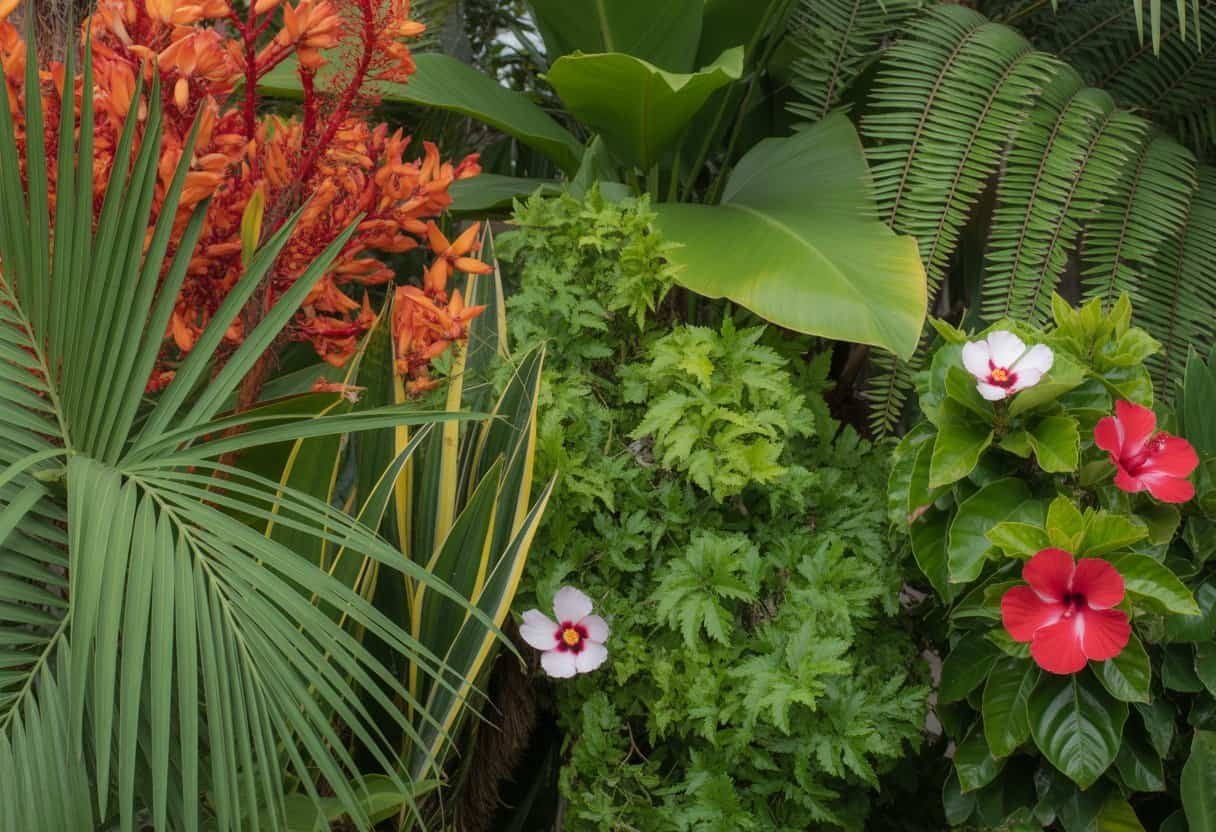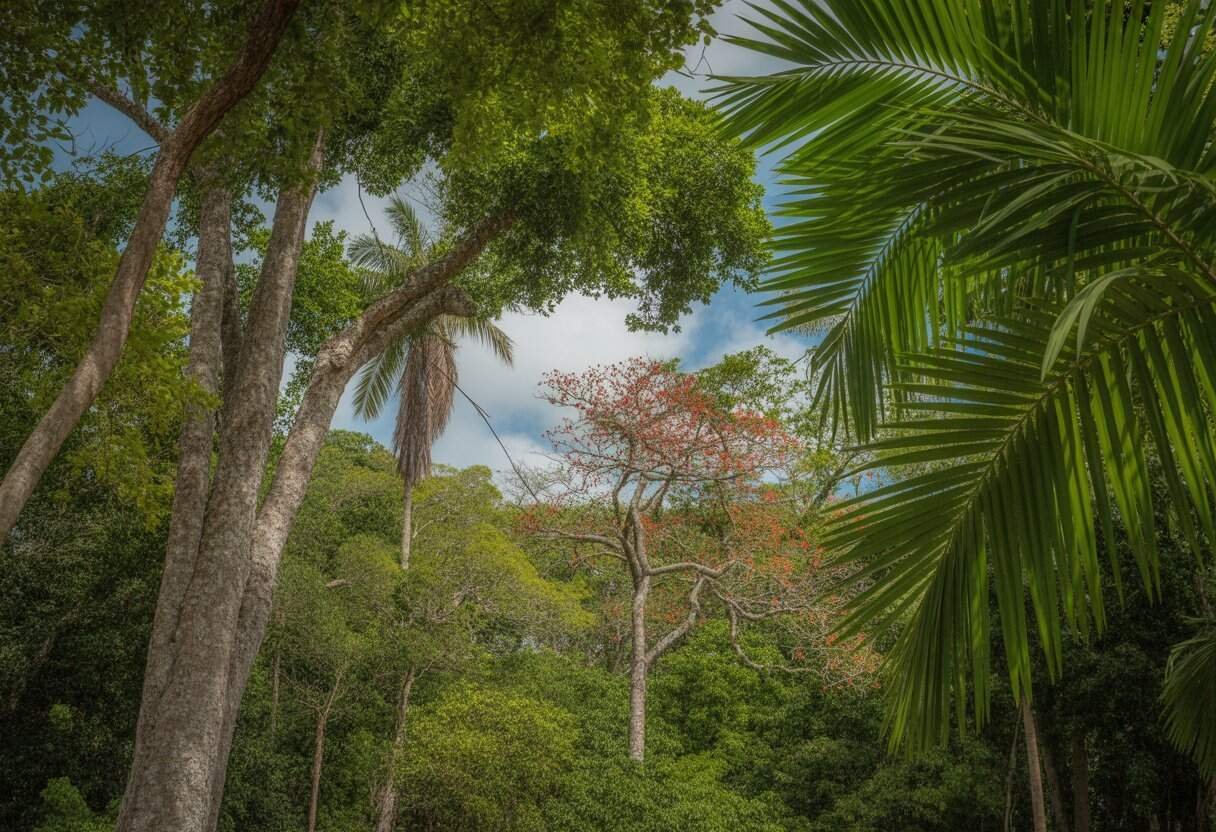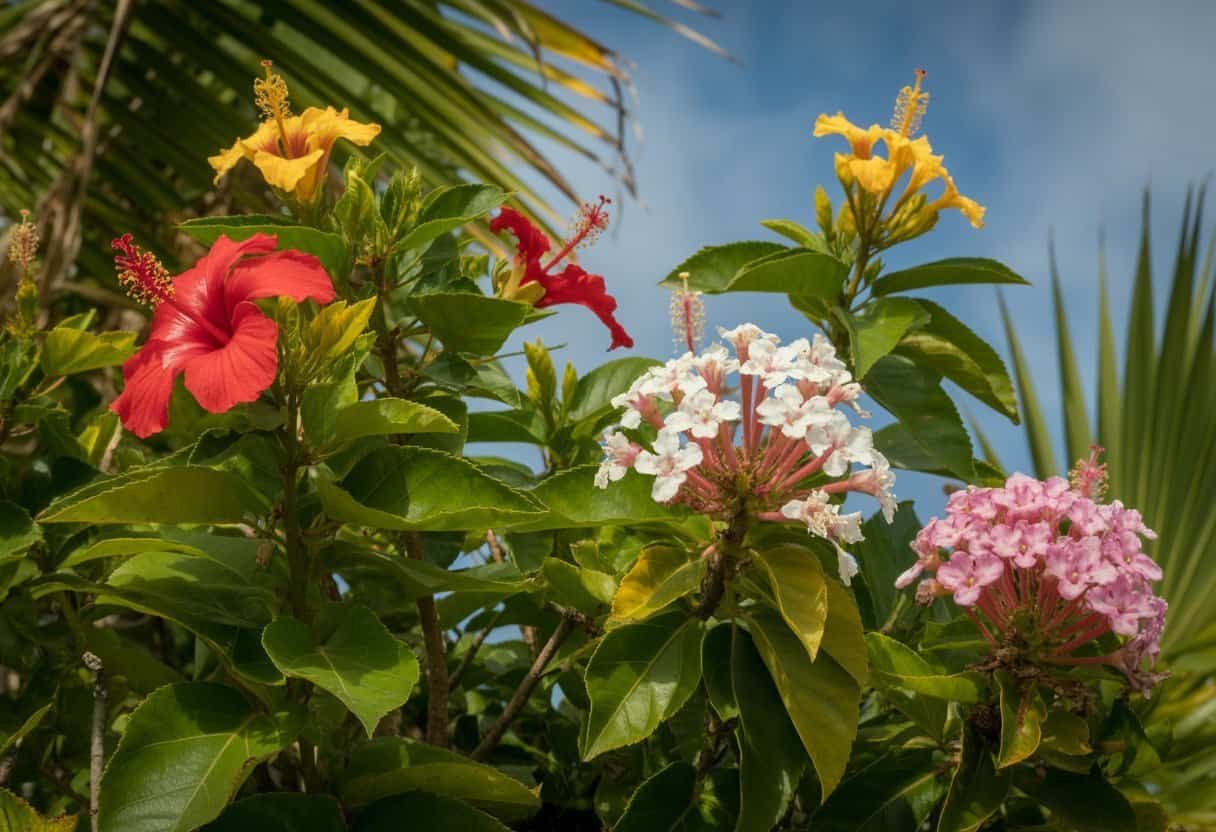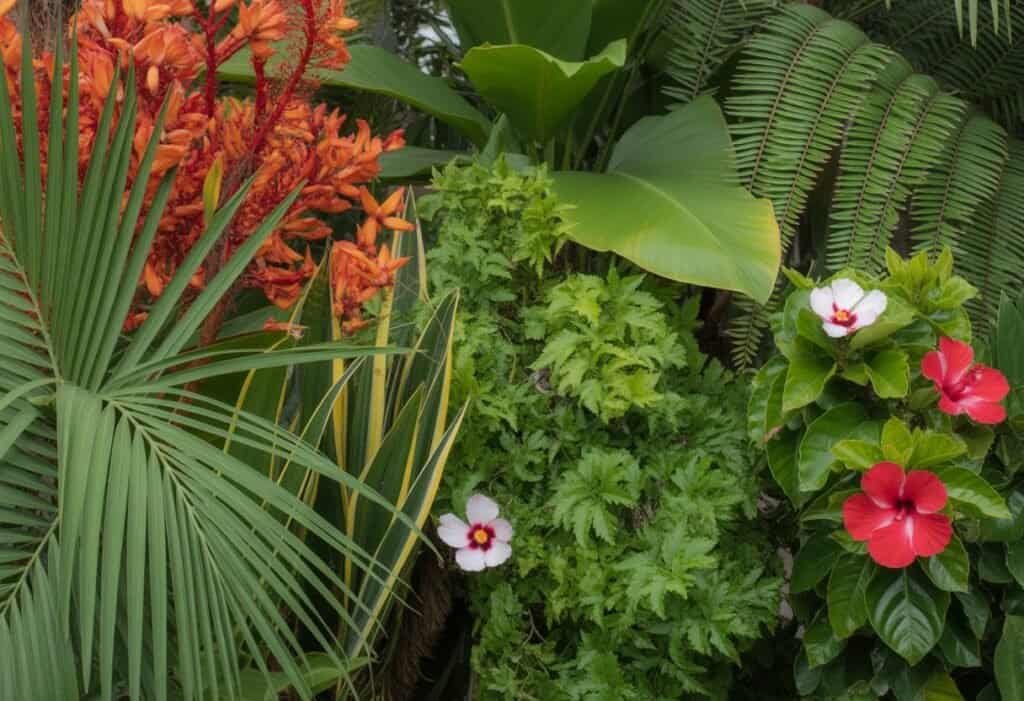Puerto Rico’s vibrant landscape is home to an incredible diversity of native plants. These plants have evolved to thrive in the island’s tropical climate.
From towering trees to delicate flowers, native plants form the backbone of Puerto Rico’s unique ecosystems. They contribute to the island’s rich biodiversity.
The island boasts over 2,800 native plant species, with approximately 240 of these being endemic, meaning they grow naturally nowhere else on Earth.

These native plants have adapted to Puerto Rico’s various microclimates, from coastal areas to mountain forests. Many have developed special features to survive hurricanes, heavy rainfall, and occasional droughts.
Some notable examples include the ceiba tree with its massive trunk, the fragrant ylang-ylang, and the vibrant flor de maga, Puerto Rico’s official flower.
Key Takeaways
- Puerto Rico’s native flora includes over 2,800 plant species with 240 endemic varieties found nowhere else in the world.
- Native plants like the ceiba tree and flor de maga have adapted to thrive in Puerto Rico’s diverse tropical environments.
- Conservation efforts are crucial to protect Puerto Rico’s unique plant species from habitat loss and invasive species.
Understanding Puerto Rico’s Unique Flora
Puerto Rico hosts a diverse range of plant species. These plants have evolved to thrive in the island’s specific environmental conditions.
The unique geography and climate of this Caribbean island have shaped one of the most diverse botanical landscapes in the region.
Characteristics of Native Plant Species
Puerto Rican native plants display remarkable adaptations to the island’s conditions. Many species have developed broad leaves to capture sunlight in the dense forest understory.
These plants often have waxy coatings to shed excess rainfall during wet seasons.
Some notable native species include:
- Ceiba (Ceiba pentandra) – An iconic tree with massive buttress roots
- Flamboyán (Delonix regia) – Known for its brilliant red-orange flowers
- Ausubo (Manilkara bidentata) – A hardwood tree valued for its durable timber
Many native plants produce vibrant flowers to attract the island’s abundant pollinators. Puerto Rico’s flora has developed unique defensive mechanisms against tropical storms.
These adaptations include flexible stems and strong root systems.
Tropical Climate and Its Influence
Puerto Rico’s climate creates ideal growing conditions for a wide variety of plants. The island receives an average of 60-70 inches of rainfall annually.
Some forest regions collect over 200 inches of rain each year.
Temperature stability plays a crucial role in plant development. Most areas maintain temperatures between 70-85°F year-round.
This allows for continuous growth cycles.
The trade winds influence plant distribution across the island. Plants on the northeastern side have adapted to consistent moisture.
Southern region species developed drought-resistance mechanisms.
Seasonal patterns affect flowering and fruiting schedules. Many plants coordinate their reproduction with the island’s wet (May-October) and dry (November-April) seasons.
Biodiversity and Local Ecosystem
Puerto Rico contains six distinct ecological zones. Each zone supports different plant communities.
The island hosts over 3,000 plant species, with approximately 250 found nowhere else on Earth.
These plants form the foundation of complex food webs. Native trees like the Sierra Palm (Prestoea montana) provide essential habitat and food for wildlife.
The relationship between flora and fauna is tightly connected. Plants like the Yagrumo (Cecropia schreberiana) have co-evolved with specific animal species for pollination and seed dispersal.
El Yunque National Forest preserves many rare species in its 29,000 acres of protected rainforest.
Introduced species and development threaten some endemic plants. Preservation of native habitats is increasingly important.
Significant Native Trees of Puerto Rico

Puerto Rico’s forests contain impressive native trees that contribute to the island’s biodiversity and cultural identity. These trees have adapted to local conditions and provide essential habitat for wildlife.
Ceiba Tree
The ceiba tree (Ceiba pentandra) stands as one of Puerto Rico’s most majestic native species. People often call it the “kapok tree.”
It can grow over 100 feet tall with a massive trunk that may reach 10 feet in diameter. The ceiba’s distinctive appearance includes a buttressed base and horizontal branches.
Indigenous Taíno people considered the ceiba sacred. They believed it connected the earthly and spiritual realms.
Many ceiba trees live for centuries, with some specimens estimated to be 300-500 years old.
The tree produces silky fibers surrounding its seeds. People traditionally used these fibers for stuffing pillows and life preservers.
During dry seasons, the ceiba drops its leaves to conserve water. This shows its adaptation to Puerto Rico’s climate.
Tabebuia Species
Tabebuia trees transform Puerto Rico’s landscape with spectacular flowering displays. Two native species particularly stand out:
Tabebuia heterophylla (Pink Trumpet Tree):
- Features stunning pink flowers that bloom in spring
- Grows 20-50 feet tall with silvery leaves
- Thrives in various habitats across the island
- Wood valued for furniture and construction
Tabebuia haemantha (Roble Cimarrón):
- Endemic to Puerto Rico, found nowhere else naturally
- Produces vibrant yellow flowers
- Grows in limestone forests and mountainous regions
- Listed as vulnerable due to habitat loss
These trees beautify the island and provide food and shelter for native wildlife, including bees and birds.
Tabonuco Forests
Tabonuco (Dacryodes excelsa) dominates the humid montane forests of Puerto Rico. These trees typically grow 80-100 feet tall with straight trunks and dense, rounded crowns.
Tabonuco forests thrive in El Yunque National Forest, where they receive abundant rainfall. These trees produce a fragrant resin.
Indigenous people historically used this resin as incense and for waterproofing canoes.
The root systems of tabonuco trees interlock underground. This network helps prevent erosion on steep slopes.
This adaptation is crucial during hurricanes and heavy rains.
Wildlife depends on tabonuco forests for habitat. These ecosystems support numerous bird species, including the endangered Puerto Rican parrot.
The trees’ fruits provide important food sources for native animals.
Iconic Puerto Rican Flowering Plants

Puerto Rico boasts several stunning flowering plants that have become symbols of the island’s natural beauty. These plants add vibrant colors to the landscape.
They also hold cultural significance for Puerto Ricans.
Flor de Maga (Thespesia grandiflora)
The Flor de Maga, officially Puerto Rico’s national flower since 1998, features large pink-red flowers that bloom throughout the year. This native tree grows to heights of 30-50 feet and thrives in Puerto Rico’s tropical climate.
The flower has five overlapping petals forming a cup-like shape with a prominent yellow stamen column. Maga trees produce these beautiful blooms consistently in favorable conditions.
The Flor de Maga holds cultural importance. Its hard, durable wood has traditionally been used for furniture making and construction.
The tree’s name comes from the Taíno word “maga,” reflecting its deep roots in Puerto Rican heritage.
Flamboyant Tree
The Flamboyant tree, also known as Royal Poinciana or Flamboyan in Spanish, creates a spectacular display with its fiery red-orange blossoms. Though not native to Puerto Rico, it has become deeply integrated into the island’s landscape since its introduction.
During summer months, these trees transform the Puerto Rican countryside with canopies of brilliant color. The Flamboyant’s umbrella-shaped crown spreads widely, creating natural shade.
Each flower has five petals—four small red ones and one larger speckled petal. After flowering, the tree produces long seed pods reaching up to 2 feet in length.
The Flamboyant appears frequently in Puerto Rican art, poetry, and songs. Its beauty and presence reflect its cultural significance.
Beautiful Flowers in Puerto Rico
Puerto Rico’s tropical climate supports many other stunning flowering plants. The Puerto Rican Hibiscus (Hibiscus puertoricensis) displays bright red flowers with long stamens.
It grows naturally in coastal areas.
The Roble Amarillo (Tabebuia chrysantha) blankets the landscape with golden-yellow blooms during dry seasons. These trees create breathtaking displays when they flower simultaneously.
Several orchid species grow naturally on the island. The Butterfly Orchid (Psychilis krugii) thrives in Puerto Rico’s rainforests and mountainous regions.
The Cordia sebestena, with its bright orange tubular flowers, attracts many pollinators. This small tree grows well in coastal areas and provides habitat for local wildlife.
Unique Shrubs and Herbs
Puerto Rico’s diverse ecosystem supports a rich variety of native shrubs and herbs. These plants have adapted to the island’s tropical climate.
They contribute to the island’s biodiversity and hold cultural significance through their traditional uses in medicine and cuisine.
Mountain Love in the Mist
Mountain Love in the Mist (Passiflora tulae) is a distinctive shrub found in Puerto Rico’s higher elevations. This plant thrives in the misty mountain regions, especially in El Yunque National Forest.
Its delicate purple flowers bloom throughout the year, attracting various pollinators. The plant grows as a climbing vine or sprawling shrub depending on its environment.
Mountain Love in the Mist survives in poor soil conditions and can withstand heavy rainfall. Its resilience makes it an important part of the mountain ecosystem.
Local conservation efforts focus on protecting this native species as development encroaches on its natural habitat.
Buttonsage and Lantana involucrata
Buttonsage (Lantana involucrata) is a hardy shrub native to Puerto Rico’s coastal regions. This drought-resistant plant features small clusters of white flowers and silvery-green foliage.
People also call it “Wild Sage.” Buttonsage grows to about 3-4 feet tall and thrives in full sun.
Its ability to withstand salt spray makes it well adapted to coastal environments.
Butterflies and bees flock to its nectar-rich flowers, making it an important food source for pollinators. The plant produces small blue-black berries that provide food for birds.
Buttonsage is increasingly used in landscaping projects focused on native species. Its low maintenance needs and attractive appearance make it popular for xeriscaping in drier parts of the island.
Medicinal and Culinary Uses
Puerto Rico’s native herbs serve dual purposes in both medicine and cooking. Culantro (Eryngium foetidum) is widely used in traditional dishes like sofrito.
It provides a distinctive flavor stronger than cilantro.
Achiote (Bixa orellana) produces seeds used as both a spice and natural food coloring. Its bright red seeds are essential in many Puerto Rican recipes and give annatto oil its characteristic color.
Several native plants have significant medicinal properties. Leaves from the guava tree treat digestive issues.
Guanábana (soursop) is used for its calming effects. Yuca (cassava) provides starch for cooking, and its leaves are also used in traditional remedies.
Many families maintain small herb gardens with these plants. The practice of using these plants for health remedies continues alongside modern medicine throughout Puerto Rico.
Native Beach and Coastal Plants
Puerto Rico’s coastlines feature unique plant species that have adapted to sandy soils, salt spray, and strong winds. These hardy plants help stabilize beaches, prevent erosion, and provide habitat for coastal wildlife.
Sea Grape and Sea Purslane
Sea grape (Coccoloba uvifera) is a common sight along Puerto Rico’s beaches. This native tree grows 25-30 feet tall with large, round leaves that have reddish veins.
Sea grape produces purple fruit clusters that resemble grapes. The fruit is edible.
The plant has an extensive root system that helps prevent beach erosion. Many coastal communities use sea grape as a natural windbreak and shade provider.
Sea purslane (Sesuvium portulacastrum) is a low-growing succulent that forms dense mats on sandy shores. Its fleshy leaves store water, helping it survive drought.
The plant displays small pink-purple flowers throughout the year. Sea purslane plays a crucial role in dune stabilization.
Its salt tolerance makes it valuable for coastal restoration projects.
Beach Morning Glory
Beach morning glory (Ipomoea pes-caprae) is easily recognized by its trailing vines. These vines can extend up to 100 feet across the sand.
The plant features thick, leathery leaves with a distinctive notch at the tip. Its large purple flowers bloom year-round, opening in the morning and closing by afternoon.
The deep roots of beach morning glory anchor sand dunes. They help prevent erosion during storms.
Beach morning glory tolerates high salt levels and drought. Its seeds travel via ocean currents, allowing the plant to colonize new areas.
Traditional healers in Puerto Rico have used beach morning glory to treat various ailments. Its leaves contain anti-inflammatory compounds.
Tree Seaside Oxeye and Tree Seaside Tansy
Tree seaside oxeye (Borrichia arborescens) grows as a woody shrub reaching 3-6 feet tall. It features silvery-green leaves and bright yellow daisy-like flowers that attract pollinators.
This plant thrives in sandy and rocky coastal environments. Its dense growth stabilizes shorelines against erosion.
Tree seaside tansy (Borrichia frutescens) closely resembles tree seaside oxeye but has more pointed leaves. It grows in habitats with occasional saltwater flooding.
Both plants provide food for native butterflies and birds. They create microhabitats that support diverse coastal ecosystems in Puerto Rico.
These species quickly recover after storms.
Rare and Endemic Puerto Rican Plants
Puerto Rico’s unique ecosystem hosts several rare plant species found nowhere else on Earth. These plants face conservation challenges due to habitat loss, climate change, and human development.
Endangered and Threatened Species
Puerto Rico is home to 49 federally listed endangered plant species. These plants represent about 5% of Puerto Rico’s native flora and require urgent protection.
The Harrisia portoricensis, a rare cactus, grows only on the islands of Mona, Monito, and Desecheo. Its population has declined by more than 80% over the past century.
Eugenia woodburyana is a small tree with fewer than 150 individuals left in the wild. It grows in the dry forests of southwestern Puerto Rico.
Conservation efforts include seed banking, habitat protection, and cultivation in botanical gardens. The U.S. Fish and Wildlife Service works with local organizations to develop recovery plans for these plants.
Passiflora tulae
Passiflora tulae, or Tula’s Passionflower, is an endemic vine found only in Puerto Rico’s mountains. This delicate plant produces small purple flowers.
The plant grows mainly in the central mountain region at elevations between 2,000-3,000 feet. It prefers moist, shaded areas in the tropical forest understory.
Key characteristics of Passiflora tulae:
- Small purple flowers (1-2 inches in diameter)
- Heart-shaped leaves with serrated edges
- Thin, climbing vines that reach 15-20 feet in length
Scientists study this species for its potential medicinal properties. Traditional healers have used it to treat nervous disorders and insomnia.
Desert Cassia and Senna polyphylla
Desert Cassia (Senna polyphylla) thrives in Puerto Rico’s dry coastal regions. This drought-resistant shrub produces bright yellow flowers.
The plant grows 6-10 feet tall and blooms year-round, providing nectar for native pollinators. Its deep roots help prevent soil erosion in coastal areas.
Indigenous people used parts of the plant to create yellow dyes for textiles. The seeds also served in traditional medicine to treat digestive ailments.
Conservation status for Senna polyphylla remains stable. However, coastal development threatens some populations, especially along the southern coast.
Local botanical gardens maintain specimens to preserve genetic diversity for future restoration.
Cacti, Vines, and Other Noteworthy Native Species
Puerto Rico’s landscape features diverse native plant species beyond trees and shrubs. Distinctive cacti and climbing vines have adapted to the island’s varied ecosystems.
Blue Torch Cactus and Tree Cactus
The Blue Torch Cactus (Pilosocereus royenii) stands out in Puerto Rico’s dry coastal areas with bluish-green stems and white wool near the top. This cactus can grow up to 20 feet tall and produces night-blooming white flowers followed by purple fruits.
Tree Cactus (Pilosocereus millspaughii) is another columnar species native to the island. It thrives in the dry southwestern regions and displays ribbed stems and spines.
Both cacti provide habitat for birds and insects. Their fruits feed native wildlife.
These drought-resistant plants store water, making them well-adapted to Puerto Rico’s dry areas.
Prickly Pear and Spurred Butterfly Pea
Prickly Pear (Opuntia species) is widespread in Puerto Rico’s arid zones. These flat-padded cacti produce vibrant yellow flowers and edible fruits called tunas.
Their adaptability to poor soil makes them resilient natives. The Spurred Butterfly Pea (Centrosema virginianum) represents Puerto Rico’s climbing vine diversity.
This delicate vine displays showy purple flowers with white markings and produces bean-like seed pods. It belongs to the legume family and fixes nitrogen in the soil, improving fertility.
Butterfly Pea vines create ground cover in forest edges and disturbed areas. They help prevent erosion and provide nectar for native pollinators such as butterflies, bees, and hummingbirds.
Hammock Viperstail and West Indian Milkberry
Hammock Viperstail (Curculigo scorzonerifolia) features pleated, grass-like leaves and small yellow flowers close to the ground. This native species often forms colonies in partially shaded areas.
It can survive drought once established. West Indian Milkberry (Chiococca alba) is a versatile native vine or shrub that produces clusters of white flowers and snow-white berries.
The plant can grow as a climbing vine or a free-standing shrub, depending on support. It thrives in various habitats from coastal areas to mountain forests.
Milkberry’s dense growth provides nesting sites for small birds. Its berries offer consistent food for native wildlife throughout different seasons.
Conservation, Threats, and Sustainable Efforts
Puerto Rico’s native plants face several challenges that threaten their survival. Natural habitats are shrinking due to development, and invasive species compete with native flora for resources.
Habitat Loss and Deforestation
Puerto Rico has experienced significant deforestation throughout its history. By the 1940s, forest cover had declined to about 6% of the island.
Forest coverage has increased to roughly 40% today, but many native plant habitats remain at risk. Urban development continues to fragment natural areas.
Coastal development threatens unique seaside plant communities. Agricultural expansion has reduced natural vegetation.
Coffee plantations, sugar cane fields, and livestock grazing have transformed large portions of the island. Climate change brings stronger hurricanes and changing rainfall patterns.
Hurricane Maria in 2017 damaged roughly 23-31 million trees across Puerto Rico. Many rare native species were affected.
Invasive Species Impact
Invasive plants threaten Puerto Rico’s native flora. Species like bamboo and African tulip tree grow aggressively and outcompete native plants for sunlight and nutrients.
Water hyacinth clogs waterways and disrupts aquatic ecosystems. This fast-growing invader can double its population in just two weeks.
The mile-a-minute vine (Mikania micrantha) smothers native vegetation by growing over existing plants. It can spread at rates of up to 20 centimeters per day.
Invasive species often arrive through ornamental plant trade or accidental introduction. Once established, they are extremely difficult to control or eradicate.
Conservation Programs in Puerto Rico
The Para La Naturaleza organization manages over 60 natural areas across Puerto Rico. Their work includes protecting habitats of endangered plant species and restoring degraded areas.
The U.S. Fish and Wildlife Service has recovery plans for 49 endangered plant species in Puerto Rico. These plans include habitat protection, invasive species control, and propagation efforts.
Local botanical gardens preserve native species through living collections. The Puerto Rico Botanical Garden in Río Piedras maintains specimens of rare plants.
Community-based initiatives engage local residents in conservation. Programs like the Citizen Science Reforestation Project involve volunteers in planting native trees and monitoring growth.
Conservation efforts extend to the nearby Virgin Islands. Joint programs help protect the shared botanical heritage of the Caribbean region.
Frequently Asked Questions
Puerto Rico hosts a diverse range of native plant species that thrive in various ecosystems. These plants have adapted to the tropical climate and play important ecological roles.
What are the most common indigenous plants found in Puerto Rican outdoor spaces?
Ceiba trees (Ceiba pentandra) are iconic native plants in Puerto Rico. Their massive trunks and sprawling branches can reach heights of over 80 feet.
Royal palms (Roystonea borinquena) appear in both natural settings and landscaped areas. This palm is native to Puerto Rico and serves as the national tree.
Flamboyant trees (Delonix regia) display brilliant red-orange flowers that brighten many outdoor spaces. Although originally from Madagascar, these trees have naturalized in Puerto Rico.
Can you list some native evergreen species from Puerto Rico?
Sierra palm (Prestoea montana) grows abundantly in El Yunque rainforest and stays green year-round. These palms thrive in the cool mountain climate and can reach 50 feet tall.
Ausubo (Manilkara bidentata) is an important evergreen timber tree native to Puerto Rico. Its dense wood resists decay and has been used for construction.
María trees (Calophyllum antillanum) have glossy evergreen leaves and grow in lowland forests. These trees produce valuable hardwood and can live for hundreds of years.
What varieties of houseplants originate from Puerto Rico?
Puerto Rican royal palm (Roystonea borinquena) seedlings can grow in containers before reaching full size. Young specimens make attractive indoor plants if there is enough space.
Spider plants (Chlorophytum comosum), though not exclusively native to Puerto Rico, grow naturally in parts of the island. Their adaptability makes them popular houseplants.
Philodendrons, especially the heart-leaf variety (Philodendron cordatum), grow naturally in Puerto Rico’s forests. These climbing plants adapt well to indoor environments and require minimal care.
Which flowers are unique to the Puerto Rican ecosystem?
Flor de maga (Thespesia grandiflora) serves as Puerto Rico’s national flower. This hibiscus relative produces striking pink-red blooms and grows naturally in Puerto Rico and nearby islands.
Heliconia (Heliconia caribaea) features bright, colorful bracts in yellow, red, and orange. These plants are endemic to Caribbean islands including Puerto Rico.
Ginger lilies (Alpinia purpurata) produce vibrant red or pink flowering bracts. Though introduced to Puerto Rico, they have become naturalized and symbolize the island’s flora.
Could you identify some plants that are exclusive to the Puerto Rico rainforest?
Sierra palm (Prestoea montana) dominates the mid-elevation areas of El Yunque rainforest. These palms create a distinctive landscape unique to Puerto Rico’s mountains.
Yagrumo trees (Cecropia schreberiana) display silver-backed leaves visible during windy conditions. These pioneer species quickly colonize forest gaps after disturbances.
What iconic flora is representative of Puerto Rican natural habitats?
Ceiba trees (Ceiba pentandra) grow in Puerto Rico’s lowland forests. Their massive trunks and wide branches make them stand out.
The Indigenous Taíno people viewed these trees as sacred.
Coconut palms (Cocos nucifera) line Puerto Rico’s coastal areas. They create the classic tropical shoreline look.
People introduced coconut palms centuries ago, but now they symbolize the island’s beaches.
Bamboo orchids (Arundina graminifolia) grow along roadsides and in disturbed areas. These resilient plants produce delicate purple flowers.


